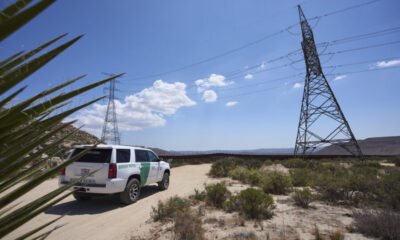ACLU
Immigration Bust Near Maricopa Reveals Border Patrol’s Evolving Mission

In February, four men were discovered concealed high in the Maricopa Mountains, near the city.
They donned camouflage over denim jeans, complete with camo ball caps and jackets. One man scanned the area through binoculars while their dark satchels held various electronic devices. Solar panels accompanied them, ensuring their communication equipment remained charged during the midday heat.
These details pointed to cartel scouts, as confirmed by U.S. Border Patrol agents who intercepted the group through a fortunate break.
“It was sun reflecting off one of the solar panels,” remarked Border Patrol Agent Robert Ortiz, noting that optical and thermal surveillance confirmed their presence.
Positioned on a peak overlooking a human smuggling route, these scouts exemplified typical cartel lookout behavior, watching for any activity below.
This arrest garnered considerable attention, particularly as the smuggling route cut directly through Maricopa, an area falling under the vast jurisdiction of the Tucson sector.
“These scouts are elusive, particularly without air support. They see us long before we reach them,” Ortiz explained during a ride-along.
Cartel scouts often set up solar-powered equipment at remote observation sites, allowing continuous communication with smuggling units.
“We know they’re active, but their elevated positions grant them an advantage. They can evade capture easily,” Ortiz added.
Agents believe these scouts monitor the border every day.
“Absolutely,” an agent confirmed. “It’s become a business.”
This operation, allegedly directed by factions of the Sinaloa cartel, highlights a critical challenge in border enforcement: while physical crossings may be observed, strategic planning often occurs far beyond conventional borders.
In response to the increasing threat, a collaborative effort with the U.S. Department of Defense enabled agents to apprehend the men promptly.
To investigate how agents function nearly 90 miles from the U.S.-Mexico border, a team met with border agents in Ajo to comprehend the evolving landscape.
As the convoy navigated rough terrain, discussions touched on agents’ personal stories and border patrol history.
Suddenly, Supervisory Border Patrol Agent Jesus Vasavilbaso instructed, “Stop the car.”
He had spotted an individual traversing the desert less than a mile from the border wall.
Ortiz immediately halted both the truck and conversation.
Two experienced agents scanned the horizon, communicating in subtle cues while they monitored for movement.
It turned out to be a false alarm—a bush swaying in the breeze against the sunlight.
Agents noted that the border situation has transformed significantly. In previous years, they encountered up to 10,000 migrants daily along this 236-mile stretch.
In 2023, Tucson’s sector chief John Modlin reported a quadrupling of migrant encounters compared to three years prior, stating the situation transitioned from “unprecedented” to “indescribable.”
Ortiz delved into political aspects by expressing nuanced observations.
“Since January, we’ve seen substantial changes,” he said, reflecting on how newer agents primarily focus on processing rather than fieldwork.
Statewide, illegal crossings fell by over 70% from January to February, according to the Transactional Records Access Clearinghouse, a federal database.
Now, throughout the Tucson sector, agents are averaging less than three dozen encounters daily.
The decrease is attributed to new asylum restrictions and enhanced detention capabilities.
“Previously, it was catch and release. Now people are aware they’ll face detention, which has changed the dynamics significantly,” Ortiz added, highlighting a shift towards pursuit rather than voluntary surrender.
Agents credited their recent success to additional support from the Department of Defense.
Military personnel now assist border operations, employing surveillance tools from specialized contractors. This collaboration allows agents to focus on interior maneuvers, disrupting cartel routes further into Arizona.
“What has changed is that the DoD can reposition as needed to maintain surveillance. They’re not engaging directly but are essential for monitoring,” said U.S. Customs and Border Protection Acting Branch Chief John Mennell.
He characterized this approach as “find, fix, and finish,” a concept adapted from military strategies.
“They locate the target and notify us for action,” Mennell elaborated.
“Our core responsibilities remain the same, yet we now operate further from the border with enhanced situational awareness,” Vasavilbaso noted.
While agents perceive the military partnership as beneficial, critics raise concerns about the increasing militarization of civilian spaces.
“The atmosphere feels different,” remarked Noah Schramm, a border policy analyst at the ACLU of Arizona.
Residents increasingly seek clarity regarding their rights when approached by military personnel or border patrol agents.
Schramm highlighted executive orders expanding military jurisdiction, warning that unwittingly crossing into designated areas could result in severe penalties.
The symbolism of military presence amidst already fragile constitutional protections raises alarms for many, he argued.
“While logistical support isn’t new, the current climate amplifies fears of military authority encroaching on civilian life,” Schramm stated.
Citing a recent order permitting military use along the border, he voiced concerns about legal ramifications for both migrants and residents, should they unknowingly enter those zones.
As community anxieties mount, Schramm emphasized the potential for encounters between armed military personnel and border residents to escalate without accountability.
In contrast, Vasavilbaso and Ortiz focus on disrupting human trafficking networks and thwarting cartel operations.
Agents characterize cartels as ruthlessly organized, operating similarly to corporate franchises.
“The cartel oversees operations while delegating tasks to local leaders who manage scouts and smugglers,” one agent explained.
Migrants often pay significant fees simply to cross the border, which does not account for additional travel or equipment costs.
“The narrative is often framed as humanitarian. However, each undocumented crossing funds cartel operations, a hard truth many overlook,” an agent stated.
Such an assessment, while accurate operationally, neglects the reasons driving migrants towards criminal networks, including systemic issues like poverty and violence.
As the vehicle transitioned from dirt to pavement, Vasavilbaso recalled a route known ominously as “The Devil’s Highway.”
In 2001, a tragic event occurred nearby involving 28 abandoned Mexican migrants, leading to significant fatalities due to neglect and harsh conditions.
The situation underscored the perils of heightened enforcement measures that redirect migrants to treacherous paths.
In response, U.S. and Mexican officials committed to collaborative efforts to avert similar tragedies in the future.
“We do our best with EMTs and rescue operations, yet our primary role remains law enforcement,” Ortiz concluded.
The evolving nature of border enforcement now extends well into Arizona’s interior, challenging traditional notions of distance from the border.
“Our measures adapt according to intelligence, which may direct us further north,” Ortiz explained.
With relationships crucial in smaller communities, agents acknowledge the role of local law enforcement in preliminary reports.
Ultimately, it was a singular reflection in the sun that led to the discovery in the Maricopa Mountains.


















